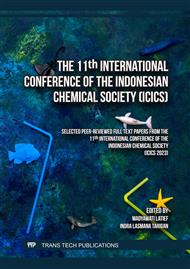[1]
A. Widyastuti and P.Santosa, Perawatan Saluran Akar dengan Instrumen Putar dan Restorasi Resin Penguat Fiber, Clin. Dent. J. 4 (2018) 9-19
Google Scholar
[2]
A. Subrata, A.E. Prahasti, and B.O. Iskandar, Influence of Two Root Canal Obturation Techniques with Resin Based Sealer to Enterococcus faecalis Penetration, J. Dent. Indones. 2 (2019) 21-18.
DOI: 10.32793/jida.v2i1.358
Google Scholar
[3]
J. Wong, D. Manoil, P. Näsman, G.N. Belibasakis, and Neelakantan, Microbiological Aspects of Root Canal Infections and Disinfection Strategies: An Update Review on the Current Knowledge and Challenges, Front. Oral. Health 2 (2021) 1-19.
DOI: 10.3389/froh.2021.672887
Google Scholar
[4]
E. Febrianifa, W. Hadriyanto, and Y. Kristanti, Perbedaan Daya Antibakeri Siler Saluran Akar Berbahan Dasar Seng Oksida Eugenol, Resin Epoksi dan Mineral Trioxide Aggregate terhadap Enterococcus faecalis, J. Ked. Gi. 7 (2016) 41-47.
Google Scholar
[5]
M. Perirokh, and M. Torabinejad, Mineral Trioxide Aggregate: A Comprehensive Literature Review Part I: Chemical, Physical, and Antibacterial Properties, J. Endod. 36 (2010) 16-27.
DOI: 10.1016/j.joen.2009.09.006
Google Scholar
[6]
A.R. Pratama, and E. Mulyawati, Penggunaan MTA (Mineral Trioxide Aggregate) sebagai Bahan Pengisi Saluran Akar pada Gigi Insisivus Lateral Kiri Maksila dengan Perforasi Saluran Akar, Maj Ked Gi 17 (2010) 19-22.
DOI: 10.22146/majkedgiind.15978
Google Scholar
[7]
A.S. Milani, S. Rahimi, Z. Borna, M.A. Jafarabadi, M. Bahari, and A.S. Deljavan, Fracture Resistance of Immature Teeth Filled with Mineral Trioxide Aggregate or Calcium-Enriched Mixture Cement: An Ex Vivo Study, Dent. Res. J. 9 (2012) 299-304.
DOI: 10.4317/jced.54075
Google Scholar
[8]
J. Camilleri, Hydration Mechanisms of Mineral Trioxide Aggregate, Int. Endod. J. 40 (2007) 462-470.
DOI: 10.1111/j.1365-2591.2007.01248.x
Google Scholar
[9]
I. Inajati, and R.T.E. Untara, Apeksifikasi dengan Mineral Trioxide Aggregate dan Perawatan Intracoronal Bleaching pada Gigi Insisivus Sentralis Kiri Maksila Non-Vital Diskolorasi, Maj Ked. Gi. Ind. 2 (2016) 101-108.
DOI: 10.22146/majkedgiind.11251
Google Scholar
[10]
N.P. Solanki, K.K. Venkappa, and N.S. Shah, Biocompatibility and Sealing Ability of Mineral Trioxide Aggregate and Biodentine as Root-end Filling Material: A Systematic Review, J. Conserv. Dent. 21 (2018)10-15.
Google Scholar
[11]
K. Al-Hezaimi, T.A. Al-Shalan, J. Naghshbandi, S. Oglesby, J.H. Simon, and I. Rotstein, Antibacterial Effect of Two Mineral Trioxide Aggregate (MTA) Preparations Against Enterococcus faecalis and Streptococcus sanguis In Vitro, J. Endod. 32 (2006) 1053-1056.
DOI: 10.1016/j.joen.2006.06.004
Google Scholar
[12]
M.W.A. Wibowo, A.I. Yunita, L. Mukaromah, I. Kartini, N. Nuryono, Effect of titania and silver nanoparticles on the tensile strength of cement-like mineral trioxide aggregate, Mater. Sci. Forum, 1068 (2022) 183-188.
DOI: 10.4028/p-673652
Google Scholar
[13]
M.A. Fakhriza, B. Rusdiarso, S. Sunarintyas, and N. Nuryono, The Addition of Copper Nanoparticles to Mineral Trioxide Aggregate for Improving the Physical and Antibacterial Properties, Indones. J. Chem., 23(3) (2023) 692 - 701.
DOI: 10.22146/ijc.79491
Google Scholar
[14]
L. Wang, C. Hu, and L. Shao, The Antimicrobial Activity of Nanoparticles: Present Situation and Prospects for the Future, Int. J. Nanomedicine 12 (2017) 1227-1249.
DOI: 10.2147/ijn.s121956
Google Scholar
[15]
S. Sharmin, M. Rahaman, C. Sarkar, O. Atolani, M.T. Islam, and O.S. Adeyemi, Nanoparticles as Antimicrobial and Antiviral Agent: A Literature-Based Perspective Study, Heliyon 7 (2021) e06456.
DOI: 10.1016/j.heliyon.2021.e06456
Google Scholar
[16]
D. Akhidime, F. Saubade, P. Benson, J. Butler, S. Olivier, P. Kelly, J. Verran, and K. Whitehead, The Antimicrobial Effect of Metal Substrates on Food Pathogens, Food Bioprod. Process. 113 (2018) 68-76.
DOI: 10.1016/j.fbp.2018.09.003
Google Scholar
[17]
E. Ghasemian, A. Naghoni, H. Rahvar, M. Kialha, and B. Tabaraie, Evaluating the Effect of Copper Nanoparticles in Inhibiting Pseudomonas aeruginosa and Listeria monogtogenes Biofilm Formation, Jundishapur J. Microbiol. 8 (2015) 1-5.
DOI: 10.5812/jjm.17430
Google Scholar
[18]
N. Raura, A. Garg, A. Arora, and M. Roma, Nanoparticle Technology and Its Implications in Endodontics: A Review, Biomater Res 24 (2020) 1-8.
DOI: 10.1186/s40824-020-00198-z
Google Scholar
[19]
A. Nazari, M.H. Rafieipour, and S., Riahi, The Effects of CuO Nanoparticles on Properties of Self Compacting Concrete with GGBFS as Binder, Mater. Res. 14 (2011) 307-316.
DOI: 10.1590/s1516-14392011005000061
Google Scholar
[20]
D. Das, B.C. Nath, P. Phukon, and S.K. Dolui, Synthesis and Evaluation of Antioxidant and Antibacterial Behavior of CuO Nanoparticles, Colloids Surf. B: Biointerfaces 101 (2013) 430-433.
DOI: 10.1016/j.colsurfb.2012.07.002
Google Scholar
[21]
B.S. Lee, H.P. Lin, J.C.C. Chan, W.C. Wang, P.H. Hung, Y.H. Tsai, and Y.L. Lee, A Novel Sol Gel Derived Calcium Silicate Cement with Short Setting Time for Application in Endodontic Repair of Perforations, Int. J. Nanomed. 13 (2018) 261–271.
DOI: 10.2147/ijn.s150198
Google Scholar
[22]
F. Bakhtiari, and E. Darezereshki, One-step Synthesis of Tenorite (CuO) Nanoparticles From Cu4(SO4)(OH)6 by Direct Thermal-Decomposition Method, Mater. Lett. 65 (2011) 171-174.
DOI: 10.1016/j.matlet.2010.09.071
Google Scholar
[23]
M. Goudarzi, N. Mir, M. Mousavi-Kamazani, S. Bagheri, and M. Salavati-Niasari, Biosynthesis and Characterization of Silver Nanoparticles Prepared From Two Novel Natural Precursors by Facile Thermal Decomposition Methods, Sci. Rep. 6 (2016) 32539.
DOI: 10.1038/srep32539
Google Scholar
[24]
A. Nazari, and S. Riahi, Effects of CuO Nanoparticles on Microstructure, Physical, Mechanical and Thermal Properties of Self-Compacting Cementitious Composites, J.. Mater. Sci. Technol. 27 (2011) 81-92.
DOI: 10.1016/s1005-0302(11)60030-3
Google Scholar
[25]
F.B. Bastruk, M.H. Nekoofar, M. Gunday, and P.M.H. Dummer, X-ray Diffraction Analysis of MTA Mixed and Placed with Various Techniques, Clin. Oral Investig. 22 (2018) 1675-1680.
DOI: 10.1007/s00784-017-2241-9
Google Scholar
[26]
S. Khan, M. Fareed, M. Kaleem, S. Uddin, and K. Iqbal, An Updated Review of Mineral Trioxide Aggregate Part-1: Compositional Analysis, Setting Reaction and Physical Properties, J. Pak Dent. Assoc. 23 (2014) 140-47.
Google Scholar
[27]
J., Camilleri, Mineral Trioxide Aggregate: Present and Future Developments, Endod. Topics 32 (2015) 31-46.
DOI: 10.1111/etp.12073
Google Scholar
[28]
X. Yu, C. Zhang, Q. Yang, and S. Kasap, Enhancement of Hardness in Nanostructured CuO/TiO2-Cement Composites, SN Appl.Sci. 2 (2020) 631.
DOI: 10.1007/s42452-020-2428-6
Google Scholar
[29]
X. Ma, H. Chen, and P. Wang, Effect of CuO on the Formation of Clinker Minerals and the Hydration Properties, Cem. Concr. Res. 40 (2010)1681-1687.
DOI: 10.1016/j.cemconres.2010.08.009
Google Scholar
[30]
I.M. El-Nahhal, J.K. Salem, S. Kuhn, T. Hammad, R. Hempelmannand, and S. Al-Bhaisi, Synthesis and Characterization of Silica-, Meso-Silica- and Their Functionalized Silica-Coanted Copper Oxide Nanomaterials, J. Sol-Gel. Sci. Technol. 79 (2016) 573-583.
DOI: 10.1007/s10971-016-4034-z
Google Scholar


